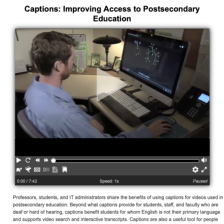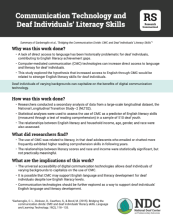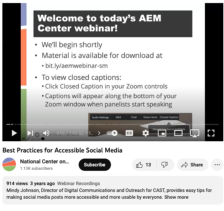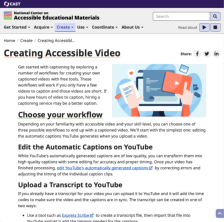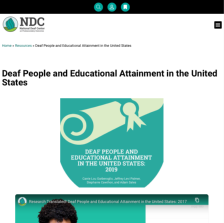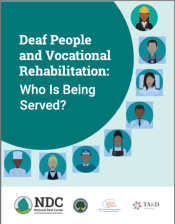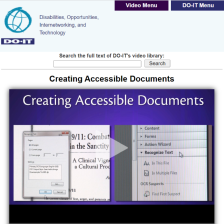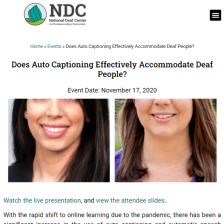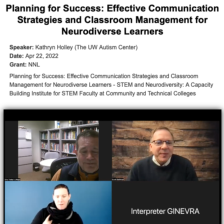Tools
Audio/Visual -- Movie/Animation
Resources | |
|---|---|
This video from DO-IT explores captioning. In the video, professors, students, and IT administrators highlight how captions on videos can improve postsecondary education for deaf or hard of hearing students, non-native English speakers, people in noisy environments, and others. The importance of accessibility, the benefits of captioning, and other...
This resource, from the National Deaf Center on Postsecondary Outcomes, provides two documents and a video that explore research on the effects of increased access to English through computer-mediated communication (CMC) on Deaf individuals' language and literacy skills. The first document is a summary of research goals, methods, findings, and...
This presentation is provided by the National Center on Accessible Educational Materials and discusses accessible social media. Social media is a powerful tool for building personal learning networks and disseminating work with others in professional communities. During this presentation, Mindy Johnson, Director of Digital Communications and...
This webpage, from the National Center on Accessible Educational Materials, includes information and tutorial videos on three different workflows for captioning video. Depending on skill level, users can choose from one of these workflows: editing the automatic YouTube captions, uploading a transcript and letting YouTube add the timing to create...
This resource, from the National Deaf Center on Postsecondary Outcomes, provides a report and video that explore data on educational attainment in the United States for Deaf individuals. The 16-page report was created by Carrie Lou Garberoglio, Jeffrey Levi Palmer, Stephanie Cawthon, and Adam Sales. In the report, key findings, data, and a research...
This 14-page report, published by the National Deaf Center on Postsecondary Outcomes, provides an analysis of the characteristics of deaf people who applied for Vocational Rehabilitation (VR) services. VR services are designed to assist individuals with disabilities in pursuing employment, providing resources such as career counseling and...
This webinar, made available by Internet Scout Research Group, features Rachel Bower and Luis Perez discussing how institutions can increase the accessibility of high quality materials for learners with disabilities. The presentation is geared towards all educators in order to make designing for accessibility easy to understand and implement...
This video from DO-IT explains why and how to create electronic documents that are accessible to all users. Examples of inaccessible documents, assistive technologies that need to be considered to make documents accessible, solutions for making documents accessible, and other best practices are covered. The video recording runs 3:54 minutes in...
This video from the National Deaf Center (NDC) explores how auto captioning and automatic speech recognition (ASR) technology accommodate deaf students and staff. Accessibility and effective communication in classrooms, meetings and events, and extracurricular activities, as well as ASR best practices are highlighted. Auto captioning compared with...
In this webinar from DO-IT, Kathryn Holley and Patti Matestic explore how educators can support neurodiverse students in the classroom. Holley and Matestic highlight support strategies, how educators can set expectations, communication, and how educators can manage disruptions. Examples of neurodiversity, functioning labels, and competing needs in...
| |
| ← Previous | Next → |
